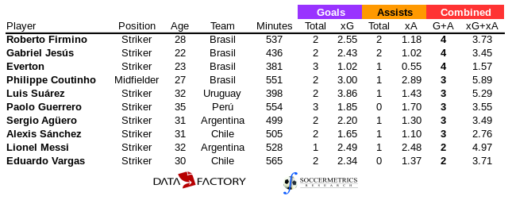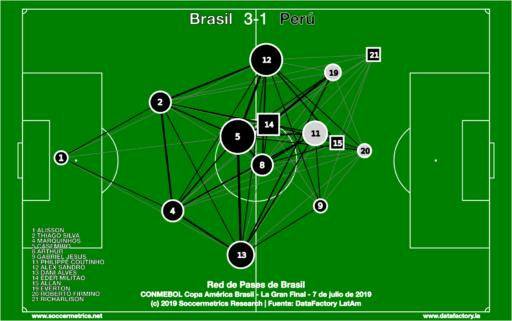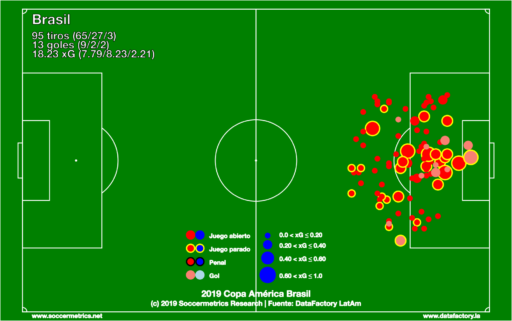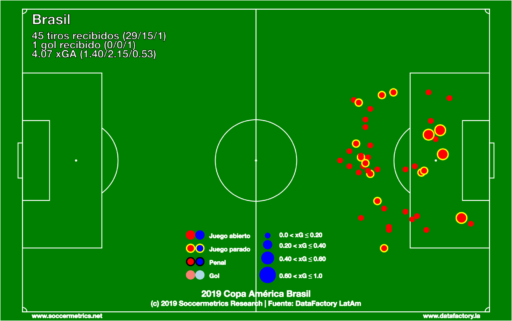Brazil dominate the 2019 Copa América
Categories: Competition Analysis
Brazil have won the 2019 Copa América for the ninth time and for the fifth time as the tournament host. It was a dominant performance from start to finish. They did not lose a match as they scored thirteen goals and allowed just one (in the final). So dominant was the Brazilian performance that all of the prizes on offer were won by the team or its players: Best Goalscorer, Best Goalkeeper, Most Valuable Player, and the Fair Play prize.
This edition of the world’s oldest continental competition was not a vintage tournament. It was full of cagey encounters, a few blowouts, and the ever-present threat of VAR. After a Copa América Centenario that featured more attacking play and clinical scoring, this year’s tournament reverted back to previous tournaments of the decade. Goals were hard to come by, and three goals were enough to be in contention for the leading goalscorer. Only three players achieved a total of four goals and assists. All three were Brazilian.

Brazil were always going to be favored to win the Copa América, but national team manager Tite deserves credit for engineering a side that succeeded despite — and perhaps because of — the absence of Neymar. Tite used 20 players from his 23-man roster and made just six rotations from the six matches. That’s the fewest among all semifinalists with the exception of Perú, whose manager Ricardo Gareca made five. Tite used the same starting lineup in the semifinal and final, and you can view the passing network from the final.

Tite stuck with a 4-3-3 throughout the tournament, with Thiago Silva, Dani Alves, Marquinhos, and either Filipe Luis or Alex Sandro making up the defensive line, Arthur and Casemiro the holding midfielders, Philippe Coutinho the attacking midfielder, and a front three of Roberto Firmino, Everton, and Gabriel Jesus. In the latter rounds, Tite was forced to turn to Sandro when Filipe Luis got injured, but there was no drop-off. Brazil generated the most expected goals per 90 minutes by a large margin (2.79 xG/90), they allowed the fewest xG per 90 minutes by a sizable margin (0.62 xGA/90), and they enjoyed a sizable advantage in the number of possessions and time on the ball.


Brazil enjoyed so many excellent performances all over the field, whether Alisson in goal, Arthur and Casemiro as the double sixes, Coutinho as a playmaker, or Everton and Firmino as part of the offensive trident. But this Copa América was Dani Alves’ tournament. Dani Alves, who plays right wing-back, was a creative force down the right flank. He led all players in final third touches in the right channel, and led all defenders in final third touches in the central region. He was 11th in expected assists (1.17) and tenth in expected goals (1.85), which was good for 11th overall in combined xG+xA. To have a defensive player act as an extra midfielder, and to do it so well, was the reason why Tite was able to exploit width so effectively.
As the scene in CONMEBOL shifts from the Copa América to the World Cup qualifying cycle, it is clear that Brazil is at the peak of the South American football landscape. And in a region of aging national teams with uncertain futures, Brazil might remain at the top for a while.
CORRECTION: I have recomputed the expected assist metrics for all of the players to correct an error in the tracking of successful free kicks and corner kicks. As a result, I reproduced the first table in the post and corrected the expected assist totals for Dani Alves.
This post has been prepared with match event data supplied by DataFactory Latinoamérica.

